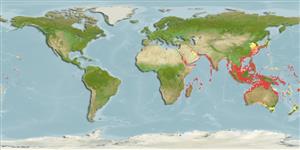Common names from other countries
Classification / Names / Names
Nomi Comuni | Sinonimi | Catalog of Fishes (gen., sp.) | ITIS | CoL | WoRMS
Environment: milieu / climate zone / depth range / distribution range
Ecologia
Demersale; salmastro; distribuzione batimetrica 0 - 100 m (Ref. 275). Tropical; 51°N - 48°S, 22°E - 155°W (Ref. 106950)
Indo-Pacific: from Japan to Australia and New Zealand coasts, from Hawaii to the East African coast, north to Red Sea and south to Madagascar. Introduced in the Mediterranean Sea.
Length at first maturity / Size / Peso / Age
Maturity: Lm ? range ? - ? cm Max length : 40.1 cm ML maschio/sesso non determinato; (Ref. 121859); Peso massimo pubblicato: 1.80 g (Ref. 275)
Also caught by set nets and spears and jigs. Demersal neritic species (Ref. 105081). Inhabits warm coastal waters (Ref. 101164). Found among rock reefs, seaweeds and estuaries (Ref. 105081). Primarily active at night and is found in shallow waters, from 0 to 100 m in depth. Moves to deeper waters or in proximity to floating driftwood, reefs, rocks, or seagrasses during daylight (Also Ref. 129713). Often solitary (Ref. 101164). Voracious (Ref. 101165) and strictly carnivorous predator (Refs. 101164, 129713). Mainly consumes mollusks, fishes (Ref. 101164) and prawns (Ref. 101165). Utilizes its characteristic tentacles to catch live prey (Ref. 101164). Exhibits cannibalism on smaller conspecifics (Ref. 101164) or among size classes (Ref. 101165).
Life cycle and mating behavior
Maturità | Riproduzione | Deposizione | Uova | Fecundity | Larve
Members of the class Cephalopoda are gonochoric. Male and female adults usually die shortly after spawning and brooding, respectively. Mating behavior: Males perform various displays to attract potential females for copulation. During copulation, male grasp the female and inserts the hectocotylus into the female's mantle cavity where fertilization usually occurs. Life cycle: Embryos hatch into planktonic stage and live for some time before they grow larger and take up a benthic existence as adults.
Roper, C.F.E., M.J. Sweeney and C.E. Nauen. 1984. (Ref. 275)
IUCN Red List Status (Ref. 130435)
CITES status (Ref. 108899)
Not Evaluated
Not Evaluated
Human uses
Pesca: commerciale
FAO - pesca: landings | FishSource | Sea Around Us
Strumenti
Fonti Internet
Estimates based on models
Preferred temperature
(Ref.
115969): 23 - 29.1, mean 28 (based on 2210 cells).
Resilienza
Alto, tempo minimo di raddoppiamento della popolazione meno di 15 mesi (K=0.73-1.25).
Vulnerability
Low vulnerability (19 of 100).
